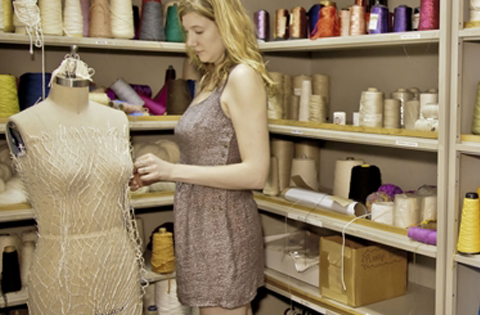Programs > Programs in the College of Art, Media, & Design
Contacts Description Learning Objectives Program Requirements

Quick Links
College of Art, Media & Design
School of Art
Liberal Arts Distribution
Contacts
Rod McCormick / rmccormick@uarts.edu / 215.717.6107
Program Director
Description
Craft & Material Studies promotes an understanding of materiality and phenomenology through study within five craft disciplines: Ceramics (CRCM), Fibers & Textile Studies (CRFB), Glass, Jewelry/Metals (CRGL), and Furniture/Wood (CRWD). A student who pursues a B.F.A. in Craft & will work closely with an advisor to determine the curricular path that best matches his or her artistic goals.
Each of the Craft disciplines will offer two distinct discipline spines:
- Ceramics Wheel Throwing ・ Handbuilding
- Fibers & Textile Studies Material & Process ・ Textile Study
- Glass Blowing ・ Color & Light
- Jewelry/Metals Jewelry Art & Design ・ Metalwork
- Furniture/Wood Furniture: Function & Beyond ・ Wood: Form & Process
Each spine contains a series of conceptually and technically related courses. These discipline spines will cover the concepts, materials and processes associated with the specific disciplines of Ceramics, Fibers & Textile Studies, Glass, Jewelry/Metals, and Furniture/Wood. Students can take these classes up to six times, building skill and testing out numerous concepts and theories as they progress.
Because each discipline has two spines, it would be possible for a student to use a combination of major and elective credits to accumulate as many as 36 credits in one set of discipline spines. The normal course of study, however, would incline a student to take a total of 27 credits in a specific discipline. The required commons courses will add 12 credits to those 27, for a total of 39 credits. The more courses a student takes in a specific discipline, the more accomplished he or she becomes. At the same time, a student who wants to study across disciplines may do so while still taking an array of courses in crafts. The commons courses will expose students to concepts and issues that confront all artists who consider materiality a central component of their practice. The sequentially linked commons courses also provide a means of assessing conceptual as well as technical advancement as the student progresses toward the degree.
The student who chooses to major in crafts has a number of curricular options, so it is important that he or she works closely with an advisor to determine each semester’s choice of coursework. During the junior and senior year, students will link information that is continually acquired in the discipline spines to the conceptual advancement required in the commons.
Learning Objectives
- To support, encourage and challenge students to develop a high level of proficiency in the production of visual art, critical thinking, analytical problem-solving and exploration while promoting flexibility, adaptability and creative cross-pollination.
- To provide a broad education. A broad education is a more pragmatic preparation for a successful future than narrow technical training can be.
- To promote individual creativity and aesthetic sophistication in order to equip students with the professional knowledge, collaborative skills and technical expertise needed to succeed in the contemporary marketplace.
- To equip students with a thorough understanding of technique and a deep familiarity with materials and process.
- To instill in students both an appreciation for the traditions of making and an appetite for questioning tradition and for exploring new ideas.
- To help the individual student develop a distinct and personal approach to art-making.
- To prepare students to enter the profession as artists, designers for industry, and entrepreneurs, or to prepare the student for further study at the graduate level.
Program Requirements (126 credits)